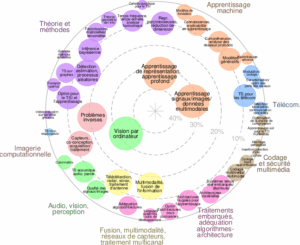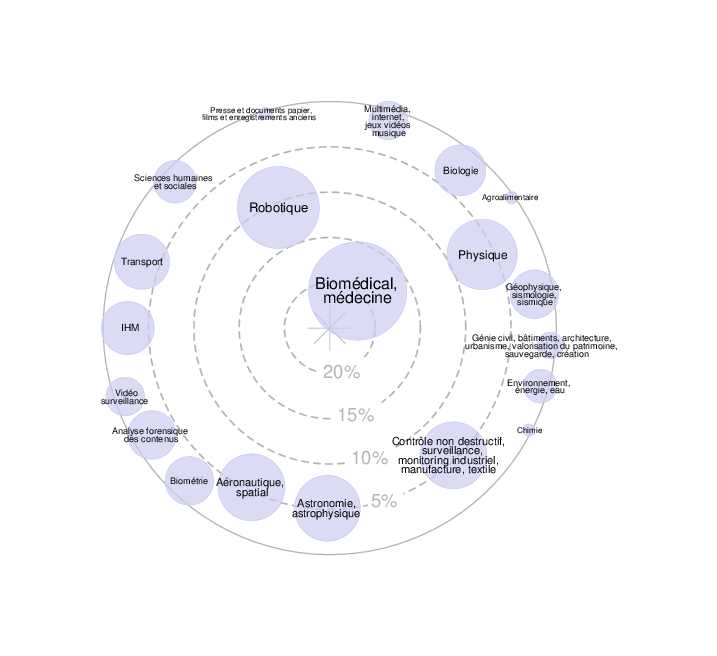Host laboratory:
Laboratoire Hubert Curien (LaHC), 18 Rue Pr B. Lauras, 42000 SAINT-ÉTIENNE.
Supervisor:
Fabien Momey Casella (fabien.momey@univ-st-etienne.fr).
Keywords:
3D (tomographic) image reconstruction, deep learning, equivariant imaging, numerical simulation, scientific programming with Matlab® and PyTorch, tomographic diffractive microscopy, biomedical applications.
Duration:
6 months. Starting date: february/march 2026.
Salary:
~ 600 euros/month.
Link to the detailed proposition.
Context and problematics:
Tomographic Diffractive Microscopy (TDM) is a quantitative optical phase imaging technique, using coherent illumination, that enables high-resolution observation of microscopic unlabeled samples [1]. Using an image reconstruction process, it provides a 3-D map of the complex optical index (refraction and absorption) of the observed sample, providing morphological information complementary to the metabolic phenomena observed using fluorescence techniques.
Measurements consist in recording interferograms (diffraction patterns) while varying the illumination angles to perform tomographic reconstructions. Geometrically speaking, the numerical reconstruction process of TDM is therefore very similar to X-ray Computerized Tomography imaging.
The IRIMAS laboratory (Mulhouse) has built such a tomographic microscope [2, 3], which has demonstrated its ability to reach an isotropic 3-D resolution in the 100 nm range. A project involving a collaboration between IRIMAS, the Hubert Curien laboratory (Saint-´Etienne) aimed at improving this imaging technique in terms of instrumentation and image processing for reconstruction. In this context, the Hubert Curien laboratory’s team managed to develop an advanced iterative reconstruction algorithm involving accurate image formation models and automatic tuning of the algorithms’s parameters [4]. The code has been implemented in Matlab®. The algorithm has shown proof of concept and has been compared with state-of-theart methods, from pre-processed data provided by IRIMAS.
However, the reconstruction methodology still suffers from inconsistencies due to ”blind spots” (missing information) in the data itself. Indeed, mechanical and optical constraints in the setup limit the angular coverage of the observation, and prevent the sample from being fully observed. This results in impossibilities to recover some spatial frequencies in the reconstructed map.
Recently, a deep learning technique, named Equivariant imaging (EI) [5], has been dedicated to alleviate such ”unseen information” issues, by enforcing invariance of the observation process to some classes of transformations. It has been successfully applied to X-ray CT imaging which presents the same kind of problems as TDM. A PyTorch library, named DeepInverse https://deepinv.github.io/deepinv/, has been developed for solving imaging inverse problems with deep learning, which includes tools for applying EI to imaging problems.
Subject of the internship:
This internship proposes to apply EI to TDM reconstruction using DeepInverse. A previous trainee has started this task by implementing the required TDM numerical models in this framework, and by creating a simulated dataset. The recruited trainee will have to continue this work in order to establish the feasibility of EI applied to TDM, on simulated data first, and secondly on experimental data. The final goal would be to publish this proof of concept in a peer-review journal at the end of the internship.
This work will be a milestone for the next step of the collaboration between IRIMAS and Hubert Curien laboratory: build a hyperspectral TDM microscope to develop a highly resolved, highly specific, label-free 3D hyperspectral optical imaging technique. The targeted application is the monitoring of the internalization of silicone nano/microparticles in living cells and tissues, for the understanding of chronic inflammatory-related diseases, including cancer, induced by silicone implants.
We are looking for a candidate in master 2 or in last year of an engineering school in computer science and/or computer vision and/or signal and image processing, comfortable with programming in the targeted language (knowledges in Python would also be appreciated), and interested in imaging problems (reconstruction, simulation), particularly for scientific research.
The proposed internship is particularely adapted for a student who plans to pursue a PhD thesis in the domain of biomedical imaging.
Required skills:
signal and image processing, computer vision, deep learning, 2D/3D image reconstruction (tomography), Matlab® programming, PyTorch.
Appreciated knowledge and interests:
Inverse problems, optics, imaging, Python programming, scientific research / project to pursue a PhD thesis.
References:
[1] O. Haeberlé, K. Belkebir, H. Giovaninni, and A. Sentenac. Tomographic diffractive microscopy: basics, techniques and perspectives. Journal of Modern Optics, 57(9):686–699, May 2010.
[2] Matthieu Debailleul, Bertrand Simon, Vincent Georges, Olivier Haeberlé, and Vincent Lauer. Holographic microscopy and diffractive microtomography of transparent samples. Measurement Science and Technology, 19(7):074009, 2008.
[3] Matthieu DEBAILLEUL and Bruno COLICCHIO. Imagerie microscopique 3d de phase méthode d’imagerie sans marquage. Techniques de l’Ingénieur, ref. article : p955, 2018.
[4] L. Denneulin, F. Momey, D. Brault, M. Debailleul, A. M. Taddese, N. Verrier, and O. Haeberlé. Gsure criterion for unsupervised regularized reconstruction in tomographic diffractive microscopy. J. Opt. Soc. Am. A, 39(2):A52–A61, Feb 2022.
[5] Dongdong Chen, Julian Tachella, and Mike E. Davies. Equivariant Imaging: Learning Beyond the Range Space, March 2021.





